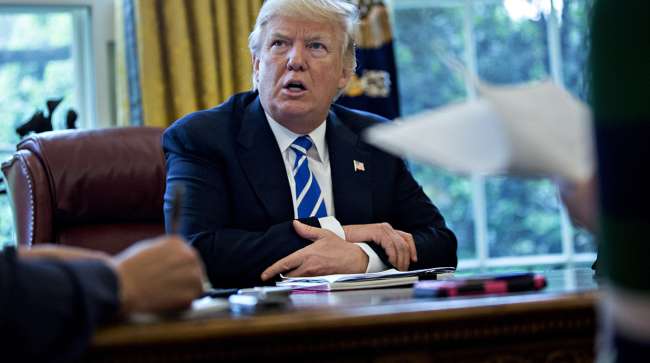NAFTA ‘Danger Zone’ Nears as Key Talks Begin Amid Trump Threats

NAFTA talks are entering a pivotal moment as the U.S. turns up the pressure on Canada and Mexico to radically alter the trade pact in favor of American interests.
In the run-up to the sixth round of talks that are now underway in Montreal, there’s been plenty of saber-rattling and posturing from the three countries. Through it all, a somewhat consistent pattern emerged: U.S. President Donald Trump kept threatening to withdraw from the pact while Canada and Mexico suggested they’d bring fresh thinking to the table to try to resolve some of the touchiest issues. The question now is whether they can move forward fast enough to salvage the deal before electoral politics overwhelm the agenda later this year.
RELATED: Trump administration losing patience over NAFTA talks
RELATED: NAFTA’s dead. Long live NAFTA. A look at most likely outcomes
“We’re reaching the danger zone right now,” said Stephen Moore, a visiting fellow at the Heritage Foundation who was an economic adviser to Trump during the 2016 campaign. “This is a pretty important meeting, because if there’s still no progress, the White House could become very frustrated and just throw up their hands and say, ‘We’re pulling out.”’
The latest session to revamp the North American Free Trade Agreement began Jan. 21 in Montreal and is scheduled to last through Jan. 29, making it the longest round yet. Talks have continued despite the U.S. government shutdown that’s consumed Washington.
The 24-year-old trade pact is a linchpin for the U.S., Canada and Mexico, which trade more than $1 trillion in goods annually. Any of the three can quit after six-months’ notice, though Trump is the only one to regularly threaten to give it.
Trump has lately tied the talks to his push for a border wall with Mexico, while the U.S. is also growing impatient with Canada’s perceived unwillingness to compromise, according to two people familiar with the negotiations who spoke on the condition of anonymity.
RELATED: Don’t assume the death of NAFTA would be a small shock, says Bank of Canada
At the same time, there are pro-NAFTA signals coming from the Trump administration, including Agriculture Secretary Sonny Perdue who said in an interview last week that Trump shares his view that NAFTA has benefits for U.S. farmers.
The Montreal round is likely to feature more substantial discussion on the five “poison pills” from the U.S., particularly autos, Brett House, deputy chief economist at Scotiabank, said in an interview, adding mounting pressure from NAFTA supporters in the U.S. is a signal that Canada and Mexico’s strategy is working.
“Rather than the notion where we’re getting to some kind of point where Canada and Mexico are over a barrel and have to blink, I actually think we’re seeing the beginning of fruit from the approach they’ve both taken so far,” House said by phone. It’s “likely negotiations are going to go on well beyond the March deadline,” he said.
There are signs of possible progress. Mexico hinted it could bend on automotive rules, one of the most explosive issues, while also saying that officials agree broadly on 40% of the pact. Canada, meanwhile, has said it will bring “new ideas” to the talks, and that several topics, known as chapters, are close to being concluded, even as Canadian officials said the chance of a U.S. exit is seen as increasing.
There are a handful of key disputes over U.S. demands. They include autos, where the U.S. wants to raise the amount of a car that must be built in the three countries to be traded under the deal. Another hot button issue includes adding a sunset clause to terminate the pact after five years unless all three countries agree to renew it.
“It’s very important to continue to make progress both with the United States and with Canada,” Mexican Finance Secretary Jose Antonio Gonzalez Anaya said Jan. 18. “Mexico will not pay for a wall. It’s not a negotiation stance for Mexico; it’s an issue of national sovereignty and dignity.”
‘How Bad?’
Canada’s chief central banker said the ongoing talks are already hurting business investment and that it’s hard to predict the impact of the death of NAFTA.
“I would believe that it would be net negative for both Canada and for the United States, but to actually quantify that is very difficult,” Governor Stephen Poloz told a news conference Jan. 17. Prices for consumers would rise and it would reverse the “income effect” that free trade deals create by boosting purchasing power, he said.
Canadian Foreign Minister Chrystia Freeland and Mexican Economy Minister Ildefonso Guajardo will hold talks in Toronto on Jan. 22. The two ministers along with U.S. Trade Representative Robert Lighthizer are scheduled to meet on the closing day of round six, while the seventh session of talks is set for February.
If the negotiations drag on too long, they could run into the political calendar. Mexico holds a presidential election July 1 and U.S. congressional midterms take place in November. Trump indicated this month that he could be flexible with talks ahead of the Mexican election — and then repeated his threat to withdraw if he can’t reach an agreement that’s “fair” for America.
“The White House seems to have dug in its heels,” said Moore at Heritage, adding it’s possible, but not likely, Trump will lose patience and quit. “That would be a really bad outcome for the economy. I think it would send shudders through the stock market. It would create a lot of chaos.”

